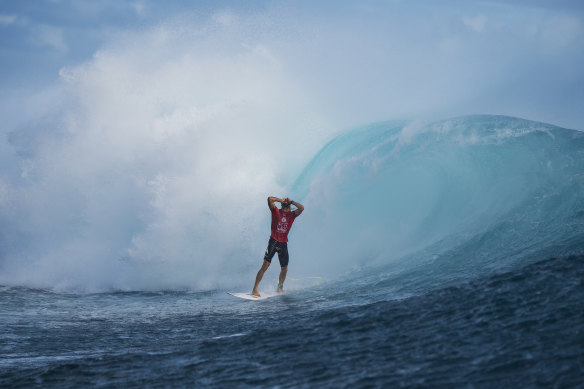By Dan Walsh
Professional surfing’s winner-takes-all, one-day finals event will shift from its often criticised location in California to Fiji’s Cloudbreak, one of the most iconic and, potentially, heaviest waves in the world.
The WSL has announced that the 2025 finals will move from Lower Trestles in San Clemente to Fiji’s most famous break, giving barrel-riding Australian contenders – including Jack Robinson and Molly Picklum – a golden chance to claim a maiden world title.
Since 2021, winners of the Championship Tour have been crowned after prevailing in the “Final Five” event, where the season’s fifth-placed finisher takes on fourth, with the winner advancing to a heat against the season’s third-ranked surfer and so on.
The format gives a big advantage to both the No.1-ranked surfer – who is one 40-minute heat away from a championship title – and whoever surfs particularly well in the conditions of the day.
Lower Trestles is regarded as a high-performance wave, with less intense waves that favour small-wave and aerial specialists.
Brazil’s Filipe Toledo is almost unbeatable in such conditions and has won the past two men’s competitions at Trestles, while Carissa Moore (Hawaii), Steph Gilmore (Australia) and Caroline Marks (USA) have prevailed as women’s champions.

Owen Wright moments after his second perfect 10 ride at Fiji’s Cloudbreak in 2015.Credit: World Surf League
Toledo has worn plenty of criticism over his performances in heavier waves such as Teahupo’o and Pipeline, while his absence from the world tour this year on mental health grounds ensures a new champion will be crowned in September.
Fiji’s Cloudbreak is as far removed from Trestles’ small-wave, high-performance environment as it gets.
The fast-breaking left-hand barrel puts most regular-footed surfers on their less-preferred backhand side at serious speed over shallow reef, and is regarded as a wave of consequence.
Events have been held at Cloudbreak previously in five- and six-metre waves, with similar swells an advantage for the WCT’s best big-wave surfers, including Robinson, Picklum and Hawaiian world No.1 John John Florence.
Robinson and Picklum have both recorded their most impressive performances surfing at Pipeline, also a fast-breaking left, and are regarded as genuine gold medal chances when Tahiti’s Teahupo’o hosts Olympic surfing in July.
Former Australian pro Owen Wright also scored a famous “perfect 20” at the 2015 Fiji Pro as the last surfer to score two perfect 10 rides in one heat, while 11-time world champion Kelly Slater ranks Cloudbreak as one of his favourite waves.
“Cloudbreak is truly one of the best waves in the world, and hosting the finals at such an iconic break is going to be incredible,” WSL chief executive Ryan Crosby said.
“As our surfers continue to push the limits at every event, Cloudbreak will be the perfect place to showcase their progression and crown our world champions next year.”
The Fiji Pro returns to the Championship Tour for the first time since 2017 as the tour’s first post-Olympics event.
Brazil’s Rio Pro is the world tour’s next stop with the event window beginning on Saturday.
World No.2 Robinson, and fellow Australian Olympic representative Ethan Ewing (ranked fourth in the world) can potentially lock in spots in this year’s finals with strong showings.
Picklum (fourth) occupies a similar position in the women’s rankings, with Tyler Wright (ninth) the only other Australian on tour.
Sports news, results and expert commentary. Sign up for our Sport newsletter.